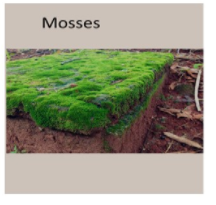
Which of the following is an example of a bryophyte
(a)Moss
(b)Fern
(c)Pinus
(d)Algae
Answer
576.6k+ views
Hint: They are commonly observed in a moist environment and are not observed in saltwater areas. Additionally, they are nonvascular plants.
Complete answer:
The term "bryophyte" comes from the Greek word where Bryon means "tree-moss" oyster means “green” and, phyton means "plant". Bryophytes are an informal group that possesses three divisions of land plants that are non-vascular. These include liverworts, hornworts, and mosses. Mostly, bryophytes will grow in moist habitats but they can also survive in drier environments. Bryophytes produce reproductive structures called gametangia and sporangia and reproduce by producing spores. They will not produce flowers or seeds.
Mosses
Moss is a taxonomic classification of Bryophytes. They are small, non-vascular, flowerless plants that will form a dense green mat, mostly in the damp or shady regions. Each plant is composed of simple leaves that appear to have only one cell thickness. The leaves will be attached to a stem that might be branched or unbranched and play a limited role in conducting water and nutrients. However, some species contain conducting tissues, which are poorly developed and structurally distinct from similar tissue found in vascular plants. Mosses will form sporophytes after fertilization and will not have seeds.
The fern and pinus are vascular plants whereas algae are nonvascular. They do not belong to the bryophyte.

So, the correct answer is ‘Moss’.
Note: The mosses are used for decoration purposes by various florists. It is a chief component of peat (dead and decaying substances) and is used for fuel. Additionally, it is used for smoking malt for scotch whiskey production.
Complete answer:
The term "bryophyte" comes from the Greek word where Bryon means "tree-moss" oyster means “green” and, phyton means "plant". Bryophytes are an informal group that possesses three divisions of land plants that are non-vascular. These include liverworts, hornworts, and mosses. Mostly, bryophytes will grow in moist habitats but they can also survive in drier environments. Bryophytes produce reproductive structures called gametangia and sporangia and reproduce by producing spores. They will not produce flowers or seeds.
Mosses
Moss is a taxonomic classification of Bryophytes. They are small, non-vascular, flowerless plants that will form a dense green mat, mostly in the damp or shady regions. Each plant is composed of simple leaves that appear to have only one cell thickness. The leaves will be attached to a stem that might be branched or unbranched and play a limited role in conducting water and nutrients. However, some species contain conducting tissues, which are poorly developed and structurally distinct from similar tissue found in vascular plants. Mosses will form sporophytes after fertilization and will not have seeds.
The fern and pinus are vascular plants whereas algae are nonvascular. They do not belong to the bryophyte.

So, the correct answer is ‘Moss’.
Note: The mosses are used for decoration purposes by various florists. It is a chief component of peat (dead and decaying substances) and is used for fuel. Additionally, it is used for smoking malt for scotch whiskey production.
Recently Updated Pages
Why are manures considered better than fertilizers class 11 biology CBSE

Find the coordinates of the midpoint of the line segment class 11 maths CBSE

Distinguish between static friction limiting friction class 11 physics CBSE

The Chairman of the constituent Assembly was A Jawaharlal class 11 social science CBSE

The first National Commission on Labour NCL submitted class 11 social science CBSE

Number of all subshell of n + l 7 is A 4 B 5 C 6 D class 11 chemistry CBSE

Trending doubts
What is meant by exothermic and endothermic reactions class 11 chemistry CBSE

10 examples of friction in our daily life

One Metric ton is equal to kg A 10000 B 1000 C 100 class 11 physics CBSE

1 Quintal is equal to a 110 kg b 10 kg c 100kg d 1000 class 11 physics CBSE

Difference Between Prokaryotic Cells and Eukaryotic Cells

What are Quantum numbers Explain the quantum number class 11 chemistry CBSE




